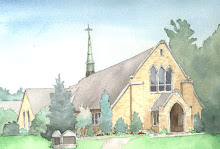It might be Lydia, from the reading in Acts, or it could be New Jerusalem, adorned as a bride in Revelation, or perhaps any of the UCW whom we are celebrating on Volunteer Appreciation Sunday at Rideau Park. Take a moment to think about the women you would celebrate, by draping them in your finest purples, lavenders, violets, indigo. then centre yourself in prayer:
You spoke light into the darkness:
light to dispel the gloom,light to form the day,
light to reveal creation’s palette,
vivid, extraordinary colours
that glanced and danced upon the face of the earth.
You came as light of the world:
light to shine in the shadows,light to point out the path,
light to pierce hearts caught in division, disharmony
that failed to see uniqueness and unity.
You call us to be light in a dark
world:
light to lead people home,light to challenge injustice,
light to weave a pattern,
that blends and shapes humanity together. Amen.
Easter 5C, but we switched the
first reading with next week …
The new community of Jesus’ followers is trying to
figure out who it is, what the boundaries should be, what this resurrection
experience MEANS.
In Easter, the OT passages become selections from
Acts (except Psalms)
READ Acts 16:9-15
Background: Acts
16:1-8
Paul has just left Jerusalem, where a “council” was
convened to shape the various initiatives of early church. Along the way he picked up Timothy – had him
circumcised “because of the Jews who were in those places”! – and carried on to
Macedonia (forbidden to go further East by the Spirit). They regularly began their contact with communities they travelled to through the synagogue, so Timothy needed to be fully Jewish.
In verses 9-12:
Paul’s dream/call to Macedonia leads him to Europe, unexpected
opportunities.
Question for
Reflection: Have you ever felt you were
being “blocked” by the Spirit? Where did
that take you?
Verse 11: Philippi “a
leading city” and “a Roman colony” – clues that tell us Philippi was strong in
trade, so it had many multicultural influences, residents with deep foundations
in their original faiths, with a layer of Roman rule over top! It acted like a Roman retirement home for
pensioned Roman officers!
3% elite
25% landowning farmers and pensioned officers
45% skilled workers, merchants
27% the poor (20% slaves)
Paul’s Sabbath observance took him to the river – was he no
longer welcome at the synagogue?
The river was a gathering place for people with Jewish roots or
interest, but not comfortable or welcomed at the synagogue. Disabilities, poverty, family conflict, lifestyle,
heritage… “we supposed there was a place of prayer.”
Verse 14 suggests that Lydia was interested in
Judaism “a worshipper of God(Yahweh)”, but who was not comfortable in the
synagogue – she had wealth, power, but perhaps not the blood lines to be welcome
there. She heard Paul’s message and was “converted”. She brought her household with her, and
offered Paul and Timothy a base in Philippi.
Question for
Reflection: Do you feel comfortable in a
church with a very different cultural background? Do you think people without WASP background
feel comfortable at RPUC?
READ Revelation 21:1-6
The book ends with “The New Jerusalem” (obviously not a
follower of Paul, who always got in trouble there!) Opposition to “the Lamb” is removed, dragon,
beast, false prophet dispatched. Like a
happy ending, Jerusalem is a bride ready to marry the hero (God?)
Contrast with “Roma” the Roman goddess who characterized Rome’s glory and power, identified with the whore of Babylon, chapter 17. Rome/Babylon signified exploitation, wasteful luxury by the rich and powerful. New Jerusalem, the bride, embodies healing, restoration.
Coded message to reject Roman imperialism, and have courage
in the hope of true justice promised by God in the true faith (still within
Judaism, but with Jesus/Lamb the clear messiah.) There will be suffering in order to ultimately
succeed.
“Behold, I am making all things new!” – prioritize your
values, Jesus turns old view upside down.
Question for
Reflection: How can the message of hope
in Revelation be twisted to suit the purpose of those who champion war or injustice? How can it be redeemed?
READ John 13:31-35
THE love command in Christianity, base of Christian ethics, identity, community.
It’s a short passage with a lot of impact!
Set in the context of Jesus’ farewell passage: a time of fear, betrayal, anxiety, despair.
In verse 31, it is not exactly clear who is glorified, and
how, or by whom. The jist, however, is
that Jesus’ life, for all its obscurity, suffering, misunderstanding is somehow
“Glory” when turned over to God.
John’s gospel uses the word glory/glorified 11+17 times – it
is clearly more verb than a state of being (for Luke the glory is more than
glorified)
-
Heavenly status/recognition of heavenly status
by the world- And yet in John, it is always linked with the cross, and the irony
- ie the process of getting the world to see/recognize the glory of the underdog
Divine presence – Jesus manifests the “Father” in a way
beyond our grasp
Suffering=gloryDeparture=arrival
Death =life
Obedience=freedom
Witness=mystery
Question for
Reflection: Can love be commanded?
Closing: Psalm 148, by James Taylor Everyday Psalms





